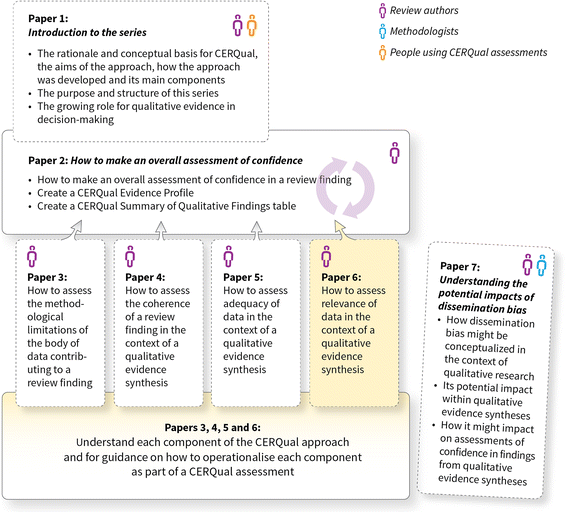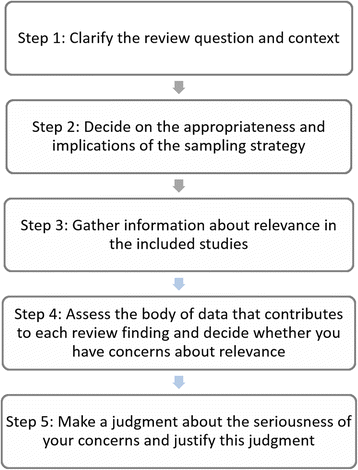Applying GRADE-CERQual to qualitative evidence synthesis findings-paper 6: how to assess relevance of the data
- PMID: 29384080
- PMCID: PMC5791042
- DOI: 10.1186/s13012-017-0693-6
Applying GRADE-CERQual to qualitative evidence synthesis findings-paper 6: how to assess relevance of the data
Abstract
Background: The GRADE-CERQual (Confidence in Evidence from Reviews of Qualitative research) approach has been developed by the GRADE (Grading of Recommendations Assessment, Development and Evaluation) Working Group. The approach has been developed to support the use of findings from qualitative evidence syntheses in decision-making, including guideline development and policy formulation. CERQual includes four components for assessing how much confidence to place in findings from reviews of qualitative research (also referred to as qualitative evidence syntheses): (1) methodological limitations, (2) coherence, (3) adequacy of data and (4) relevance. This paper is part of a series providing guidance on how to apply CERQual and focuses on CERQual's relevance component.
Methods: We developed the relevance component by searching the literature for definitions, gathering feedback from relevant research communities and developing consensus through project group meetings. We tested the CERQual relevance component within several qualitative evidence syntheses before agreeing on the current definition and principles for application.
Results: When applying CERQual, we define relevance as the extent to which the body of data from the primary studies supporting a review finding is applicable to the context (perspective or population, phenomenon of interest, setting) specified in the review question. In this paper, we describe the relevance component and its rationale and offer guidance on how to assess relevance in the context of a review finding. This guidance outlines the information required to assess relevance, the steps that need to be taken to assess relevance and examples of relevance assessments.
Conclusions: This paper provides guidance for review authors and others on undertaking an assessment of relevance in the context of the CERQual approach. Assessing the relevance component requires consideration of potentially important contextual factors at an early stage in the review process. We expect the CERQual approach, and its individual components, to develop further as our experiences with the practical implementation of the approach increase.
Keywords: Confidence; Evidence-based practice; GRADE; Guidance; Methodology; Qualitative evidence synthesis; Qualitative research; Relevance; Research design; Systematic review methodology.
Conflict of interest statement
Ethics approval and consent to participate
Not applicable. This study did not undertake any formal data collection involving humans or animals.
Consent for publication
Not applicable
Competing interests
The authors declare that they have no competing interests.
Publisher’s Note
Springer Nature remains neutral with regard to jurisdictional claims in published maps and institutional affiliations.
Figures
References
-
- Lewin S, Glenton C, Munthe-Kaas H, Carlsen B, Colvin CJ, Gulmezoglu M, Noyes J, Booth A, Garside R, Rashidian A. Using qualitative evidence in decision making for health and social interventions: an approach to assess confidence in findings from qualitative evidence syntheses (GRADE-CERQual) PLoS Med. 2015;12(10):e1001895. doi: 10.1371/journal.pmed.1001895. - DOI - PMC - PubMed
-
- Munthe-Kaas HM, Bohren M, Carlsen B, Glenton C, Lewin S, Colvin CJ, Tuncalp Ö, Noyes J, Booth A, Garside R, et al. Applying GRADE-CERQual to qualitative evidence synthesis findings––paper 3: how to assess methodological limitations. Implement Sci. 2018;13(Suppl 1) 10.1186/s13012-017-0690-9. - PMC - PubMed
Publication types
MeSH terms
Grants and funding
LinkOut - more resources
Full Text Sources
Other Literature Sources



